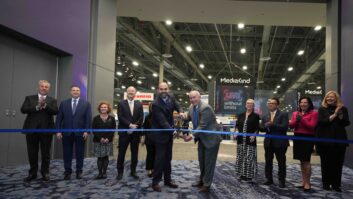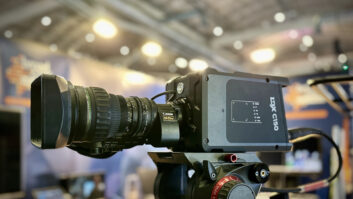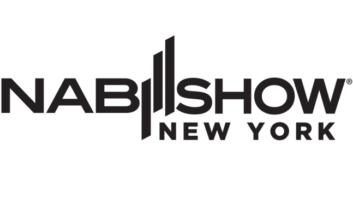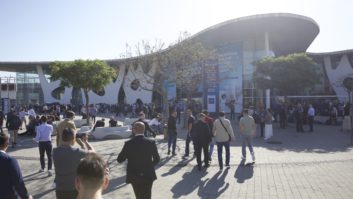
Dick Hobbs leads off our lean-back NAB reflection section, with a look at core broadcast infrastructure. Deliverable cost-effectiveness dominated throughout, whether in multiscreen, social media, storage, MAM or playout automation.
“Sinclair is a sales organisation: technology is just a tool. It’s all about the money.” Those words were uttered by Del Parks of US station chain Sinclair Broadcast, at the Harris press conference on the eve of NAB this year. It was a prescient view of what to me was the prevailing message coming out of this year’s event.
With one or two exceptions there was not much technology for technology’s sake. Sony and Panasonic both tried to push the 4k agenda, but there seemed little interest. Talking subsequently to Andy King of BBC Vision Production, he was bemused by the pressure to push acquisition quality up by some vendors, while another told him, in so many words, “if it is good enough for Skype it is good enough to broadcast”.
In general, though, the manufacturers were tackling the real issues we face at the moment, including the integration of traditional broadcast and IP infrastructures and the need to address multi-screening and social media, with the major emphasis on cost-effectiveness.
Michel Proulx, CTO of Miranda, made the point that “Multi-platform is the curve ball the industry has thrown us. It’s a remain-in-business platform – there is no revenue. The old business model is at breaking point. You need a simpler model with fewer moving parts”.
One of the ways of reducing moving parts is around social media. Several exhibitors, including Miranda and Chyron had new applications which put Twitter feeds and other social media within the news production process, rather than as an afterthought, ensuring that the comments had the same editorial authority as the news story itself.
The Ross offering, Inception, seemed to me to be particularly well integrated. It is a plug-in for a production system that tracks the social feeds along with the rest of the production and playout workflow.
That allows what David Ross described as a call to action feed. If there is an interesting scoop coming up, a tweet timed for a minute or so before the story is broadcast could call those interested to turn on their televisions or tune to the appropriate channel. Because Inception is a plug-in to the newsroom, the tweet will be sent out at the right moment even if the running order of the news broadcast changes. Yes, I suspect that the biggest use will be for celebrity gossip stories, but if that is what builds the audience then that is good.
Kit Digital’s vision is of a television industry tightly linked to social media, and launched at NAB what it calls the Social Program Guide. It is designed to replace the traditional EPG and remote control, integrating the second screen and its social functionality.
Avid was also talking about integrating social media and multi-platform delivery, through a new add-on product MPD. This works with Interplay and iNews to add functionality through web services APIs. It tackles one of the key goals of multi-platform news, to create once and publish everywhere. It also offers a two-way connection with the online world, not only to search for content created for non-broadcast platforms but to collect information on what is successful and getting bit hits. If a story is trending on Twitter, it is good for the journalist running it to know.
Avid also talked about new approaches to storage and asset management, and indeed in his presentation CEO Gary Greenfield offered a subtle change in language, talking about “asset workflows” rather than files. His point was that content is the broadcaster’s main asset, and the focus should be on wringing the utmost value out of it. “Nothing should be left on the cutting room floor,” he said. “It is all about re-use.”
That was echoed by EVS with its new Sports 360 application that aims to maximise the usage of content, and therefore the revenue opportunities. One suite offers advanced media production, archive research, and instant package creation and distribution to broadcast and online audiences.
EVS showed a brilliant example of what can be achieved with its C-Cast system, part of Sports 360. The company claims it is the first system to allow instant distribution of multiple camera angles from live events. The demonstration I saw was developed for the Euro2012 football, and allowed consumers to pick their own replays from an iPad app. By the time you read this we will know which broadcasters will offer this service, but if you get a chance to use it then you certainly should.
SOAs and storage
Talking of iPad apps, asset management specialist TMD showed another good one. Because it has developed web services access to its systems it can put application-specific functionality onto different devices. This one would be great for a busy broadcaster or playout company.
A producer issues a work order to an editor to create a set of promos, and when the editor completes the task sends a notification back to the producer. With the new TMD app, the producer can pick up the notification on an iPad, view the work in full HD resolution, and either approve it (in which case it is automatically transferred to playout) or add notes for the editor in the metadata detailing what else needs to be done. Very slick.
With the growing interest in service-oriented architectures, like the Grass Valley Stratus, there is a movement to regard asset management systems not as entities in themselves but as just one device – albeit a large and important device – which serves the workflow. Both Pilat Media and Snell talked about systems that are workflow engines with asset management built in, not the other way around.
Snell’s new Momentum system is designed as a thin-client SOA that wraps workflow automation and resource management along with MAM. It also includes business analytics to model operations, calculate profitability and plan for investment only when it opens up real revenues.
Pilat Media included expanded functionality for multi-dimensional rights management, a topic also tackled by new and updated modules from Sintec Media. Whereas once buying the rights to content meant you had a set number of transmissions, now rights can include broadcast resolutions, regions, devices, delivery platforms and revenue models. As Moses Zelnicker of Sintec told me, “the biggest challenge is in the GUI, making it understandable.”
From asset management to storage, and the talk at NAB was of big numbers. Avid Isis can now cope with storage measured in the petabytes, and Aberdeen showed a very nice “Petabyte in a Rack” system. One of the new tricks that Bluefish’s modular card can do is turn any standard computer into an Avid media server, drawing on whatever storage capacity that computer can support.
On the smallest booth at the show, HVault was showing a holographic archive. I understand only the basics of how this works – lasers create optical patterns of light and dark pixels which allow parallel read and writes in the millions of bits – but HVault was promising 50+ year archive life, power consumption 1% that of disk or tape, and less than 10 seconds to access any content.
The biggest announcement in big storage, though, was Quantel’s RevolutionQ. This is effectively a limitless online content store. Its beta test customer is a major American broadcaster, paying more than $10 million for a 10 petabyte system. At 50Mbps encoding, that represents around 50 years content.
What makes this vast online store possible is a new Quantel Virtual File System, which in turn uses the rapidly emerging MXF AS-02 bundle structure. Quantel claims that together they allow an infinite number of media assets to be online, and delivered to any user with latency measured in seconds. It uses schema-free metadata, so any third-party application can be attached, just picking the metadata it needs.
If you do not want everything online, GB Labs had applied a bit of lateral thinking to LTO-5 tape libraries. Apparently the BBC was interested in using data tapes for archive but was concerned about the longevity of the media if the tapes were repeatedly scrubbed across the heads. The GB solution was to feed the drive at its native speed so reads and writes were continuous. The challenge is that the native speed is 140Mbps which is far faster than other systems can match. GB built boxes based on fast ethernet with local buffer drives to meet the challenge.
A clever alternative
A quick word about playout automation. The gulf between traditional best of breed systems and Channel in a Box devices is growing: Scott Murphy of NVerzion – which makes an excellent best of breed system called Class – claimed there were 32 Channel in a Box providers at NAB. Not sure if that included the potential new entrant showing a very impressive system in a whisper suite.
Pixel Power came at the automation challenge from branding, with its Gallium system now gaining users. Miranda acquired iTX 18 months ago and has spent that time developing a graphics and branding solution for it, based on Adobe After Effects. Both Snell and Pebble Beach (which offers both classes of automation) had integrated graphics and effects from RT, with Pebble Beach showing a particularly impressive two channel 3D squeezeback with live video on both channels.
Aveco had added to its range with a disaster recovery system, an important requirement in itself. It has sold such a system to Televisa, which makes the best use of the hardware by running low revenue channels out of the disaster recovery site until it is needed for its primary purpose.
There was much more of interest at NAB but space prevents me from detailing it all. I do want to mention, though, another clever bit of lateral thinking, from an Italian company called Sisvel Technology. Noting that current frame compatible 3D transmission systems resulted in halved resolution, it proposed a clever alternative, using 720 line HD in a 1080 line carrier.
The left eye goes in the top left hand corner, leaving space at the bottom and right hand side. The right eye is chopped into three at transmission and fitted into the available space, which still leaves a black area in the bottom right hand corner. The result is true HD 720 line 3D for both eyes.







